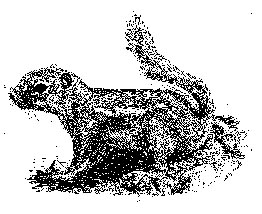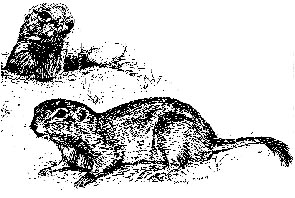|
Description
Two genera of ground squirrels are found in Arizona - Ammospermophilus
and Spermophilus.

Rock squirrels
|
There are two species of Ammospermophilus, commonly referred to
as antelope ground squirrels, in Arizona. The antelope name probably comes
from the fact that when running, they hold their tails up and often arched
over their backs exposing a white or buff colored undersurface which resembles
that of a pronghorn "antelope" running. Antelope ground squirrels
can be distinguished from other squirrel-like rodents by their well developed
white stripe extending from shoulder to hip on each side.
There are five species of Spermophilus found in Arizona in nearly
all kinds of habitats. Two species are more commonly associated with human
habitation. These are the rock squirrel (S. Variegatus) and the
round-tailed ground squirrel (S. tereticaudus).
The rock squirrel is the largest of the ground squirrels and is often
confused with a tree squirrel. Rock squirrels have a long bushy tail,
grayish or brownish or reddish in color and mottled with light gray or
whitish specks or spots.
The round-tailed ground squirrel is a small to medium, uniformly colored
light buff to darker squirrel with small ears, a tail covered with short
hairs giving it a rounded appearance. This ground squirrel resembles a
miniature prairie dog.
The five species of chipmunks in Arizona all belong to the genus Eutamias
are similar in appearance. The chipmunk is a small, brownish, ground-dwelling
squirrel more closely related to ground squirrels than to tree squirrels.
Chipmunks are generally smaller than the ground squirrels, have a bushy
tail, and longitudinal dark stripes on their backs.
Distribution in Arizona
In general, the white-tailed antelope ground squirrels are found north of the
Mogollon Plateau and the Harris' antelope ground squirrels are found south of
the Mogollon Plateau.
Species of Spermophilus occur in Arizona in nearly all kinds of habitats
except in densely wooded areas. The rock squirrel is associated with rocky habitats
and is absent from the southwestern desert areas of the state. The round-tailed
ground squirrel is generally found in the deserts of western and southern deserts
Chipmunks are found throughout the state, most often associated with coniferous
forests. The cliff chipmunk is also found in scrub oak and manzanita habitat
and the Colorado chipmunk is associated with pinon-juniper areas. The Least
chipmunk is generally found at higher elevations, in sagebrush areas away from
conifers.

Least Chipmunk
|

Antelope ground squirrel |
|
Legal Status in Arizona
All of Arizona's ground squirrel and chipmunk species are classified as non-game
animals by the Arizona Game and Fish Department and are protected under ARS
Title 17-309. However, may be controlled by any legal means if they are causing
damage as per ARS Title 17-239.
If live trapped ground squirrels or chipmunks are to be relocated, the Arizona
Game and Fish Department must be contacted for an appropriate release site before
the animal is transported.
Life History and Behavior
Both ground squirrels and chipmunks are active during the day and are easily
seen when foraging. But they spend much of their time in their burrows. In winter,
most ground squirrels and chipmunks go underground and stay inactive. In the
hotter desert areas, ground squirrels may go into a period of estivation (summer
hibernation) when temperatures are high.
Most Arizona ground squirrels and chipmunks will have just one litter per year
born from February through mid-September depending on species. In southern Arizona
most ground squirrel litters may be born as early as March and in colder areas
young may be born through May.
Both ground squirrels and chipmunks nest in underground burrows. These burrow
entrances are always open and are not plugged with soil as are pocket gopher
burrows entrances. Burrow systems may be extensive and have several entrance/escape
holes. Rock squirrel burrows are generally found around rocky areas and in residential
areas they are often dug under cement slabs and pool decks. Antelope ground
squirrels tend to locate burrow systems and entrances under vegetative cover
whereas round-tailed ground squirrels seem to prefer more open areas. Round-tailed
ground squirrels are often associated with creosote bush, desert areas where
they climb up the creosote to feed on the fruit.
These animals all have internal cheek pouches to transport food and some store
food in underground caches. They all are rapid runners and always retreat to
their burrows when frightened. Although they are generally considered ground
dwellers, most ground squirrels and chipmunks will climb cacti, small bushes
and trees in search of food.

Round-tailed ground squirrel
| 
Rock squirrel |
|
Food Habits
Ground squirrels are primarily vegetarians, feeding on green vegetation, seeds,
and fruit. Rock squirrels will also feed on carrion and kill small rodents and
birds. Chipmunks eat both plant and animal material, from seeds, nuts, insects
and worms to small birds and frogs.
In general, these animals will feed on green vegetation during the summer and
switch to grains and seeds late in the season and early in the spring when green
vegetation is not available.
Damage and Identification
A number of species of squirrels and chipmunks occasionally become pests in
and around buildings. When ground squirrels or chipmunks are present in large
numbers they can cause structural damage by burrowing under patios, stairs,
retention walls, or foundations. They may also invade garages, walls and attics.
They will also consume flower bulbs, seeds, or seedlings as well as bird seed,
grass seed, and pet food that is not stored in rodent-proof storage containers.
The identification of ground squirrel or chipmunk damage is most often made
by direct observation and the presence of burrow entrances.
Ground squirrels and chipmunks are sometimes implicated in the transmission
of plague to humans, especially when rodent populations are dense.
Author: Lawrence M. Sullivan
Extension Wildlife Damage Management Specialist
School of Renewable Natural Resources
The University of Arizona
| |